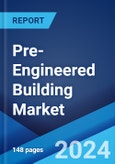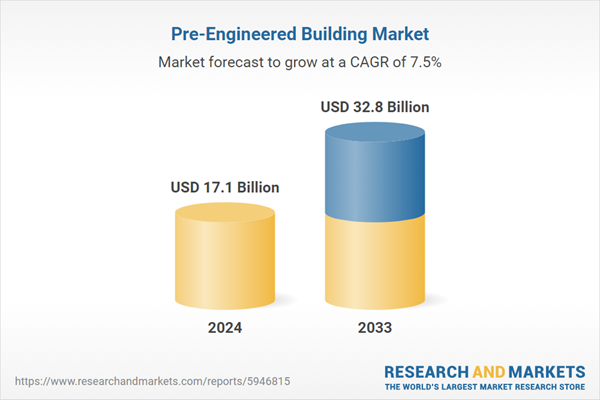A pre-engineered building (PEB) is a structural system that is designed and fabricated in a factory before being transported to the construction site for assembling. It is a versatile and cost-effective solution meticulously designed using advanced software, which ensures precise measurements and optimal use of materials. It is quicker to construct and aids in reducing project timelines and minimizing disruption to surrounding areas. It is widely used for manufacturing plants, warehouses, and distribution centers due to their cost-efficiency and rapid construction. Besides this, it is well-suited for barns, storage facilities, and agricultural processing units, providing ample space and durability.
The rising awareness among individuals and businesses about the advantages offered by modular and prefabricated construction methods is creating a positive outlook for the market. Additionally, increasing costs of labor and materials in the construction industry are encouraging more organizations to consider cost-effective PEB solutions as an alternative to traditional construction. Apart from this, continuous rise in e-commerce is driving the need for warehouses and distribution centers, which is positively influencing the market. PEBs are well-suited for such facilities due to their cost-efficiency and fast construction. Moreover, the increasing need to replace or upgrade aging infrastructure is driving the demand for modern, cost-effective building solutions across the globe.
Pre-Engineered Building Market Trends/Drivers
Sustainability and environmental awareness
The global focus on sustainability and the increasing need for mitigating climate change represent one of the key factors favoring the market growth. Additionally, the escalating demand for energy-efficient design elements, such as insulation, reflective roofing materials, and energy-efficient HVAC systems, is driving the adoption of PEBs. Apart from this, rising preferences of individuals and businesses for sustainable sourcing and materials with low environmental impacts are encouraging industry investors to focus on the development of recycled and eco-friendly materials used in construction. Furthermore, governments of various countries are implementing regulations and offering incentives for sustainable building practices, which is promoting the adoption of PEBs.Rapid urbanization and infrastructure development
The rising global population and the increasing construction of commercial, industrial, and residential spaces are stimulating the market growth. Additionally, the escalating demand for buildings and infrastructure in rapidly growing urban areas is offering lucrative opportunities to the market players. PEBs are easy to install and can be constructed in a fraction of the time as compared to traditional construction methods. Apart from this, the rising demand for PEBs in infrastructure development, including airports, transit stations, and storage facilities on account of their design flexibility and speed of construction is strengthening the growth of the market. Furthermore, the integration of smart building technologies to improve energy management and security is favoring the market growth.Technological advancements in PEB design and manufacturing
Advancements in technology and innovations in the design and manufacturing processes of PEBs to enhance their quality, efficiency, and customization options are the other major factors influencing the market positively. Additionally, the increasing use of sophisticated three-dimensional (3D) modeling and design software to enable precise planning and visualization of PEB structures and ensure optimal use of materials and structural integrity is creating a positive outlook for the market. Apart from this, the rising reliance of PEB manufacturers on automated manufacturing processes, which include computer-controlled cutting, welding, and shaping of steel and other materials is driving the market. Furthermore, the integration of the Internet of Things (IoT) sensors and remote monitoring systems is attracting a wider consumer base.Pre-Engineered Building Industry Segmentation
This report provides an analysis of the key trends in each segment of the global pre-engineered building market report, along with forecasts at the global and regional levels for 2025-2033. The report has categorized the market based on product and end-user.Breakup by Product
- Concrete Structure
- Steel Structure
- Civil Structure
- Others
The report has provided a detailed breakup and analysis of the market based on the product. This includes concrete structure, steel structure, civil structure, and others. According to the report, steel structure holds the largest market share as it requires minimal maintenance and offers cost advantages. Additionally, it provides exceptional strength, durability, and versatility, which makes it suitable for various applications, including warehouses, factories, and commercial buildings. Apart from this, steel has fire-resistant properties, which ensure the safety of occupants and the protection of valuable assets within the building. It also lowers insurance costs, making steel structures an economically viable choice. Moreover, steel structure PEB components are manufactured in controlled environments, which ensures high-quality standards and consistency. This consistency minimizes the risk of errors during construction and guarantees structural integrity. Moreover, pre-engineered steel buildings can be designed with energy-efficient features, such as insulation and advanced heat, ventilation, and air-conditioning (HVAC) systems.
Breakup by End-User
- Industrial Sector
- Commercial Sector
- Infrastructure Sector
- Residential Sector
A detailed breakup and analysis of the market based on the end-user has also been provided in the report. This includes the industrial sector, commercial sector, infrastructure sector, and residential sector. According to the report, the industrial sector represents the largest market segment as PEBs are widely used for manufacturing plants, warehouses, distribution centers, and industrial facilities. They provide cost-effective, large-span structures that can be quickly erected, meeting the demand for efficient storage and manufacturing spaces. Additionally, PEBs are designed to meet and exceed industry-specific standards and codes, which ensures that industrial facilities comply with safety and regulatory requirements. Apart from this, PEBs offer a high degree of customization to meet the specific needs of industrial operations, which include manufacturing facilities, warehouses, and distribution centers. Moreover, industrial clients require buildings that can accommodate heavy machinery, storage, and logistics, and PEBs are designed with these requirements in mind, allowing for large clear spans and high ceilings to house equipment and inventory efficiently.
Breakup by Region
- North America
- Europe
- Asia Pacific
- Middle East and Africa
- Latin America
The market research report has also provided a comprehensive analysis of all the major regional markets, which include North America, Europe, Asia Pacific, Middle East and Africa, and Latin America. According to the report, Asia Pacific accounted for the largest market share due to rapid urbanization. Additionally, the expansion of various industries is offering a favorable market outlook. Apart from this, the rising need for quick and cost-effective construction solutions to meet expanding urban infrastructure requirements is catalyzing the demand for PEBs in the Asia Pacific region. Additionally, rapid infrastructure development, including airports, stadiums, and commercial complexes is supporting the growth of the PEBs market in the region. Apart from this, Asia-Pacific is prone to various natural disasters, including earthquakes and typhoons, which drive the demand for PEBs with structural integrity and resilience to withstand these challenges. Furthermore, the presence of robust manufacturing infrastructure in the region ensures the availability of high-quality PEB components.
Competitive Landscape
PEB companies are investing in advanced design and engineering capabilities and leveraging cutting-edge software and technologies. This allows them to create more efficient and customizable PEB solutions, meeting the unique needs of diverse clients. Additionally, many PEB companies are adopting sustainable practices and are using eco-friendly materials, energy-efficient designs, and green building certifications in their offerings to cater to the growing demand for environmentally responsible construction. Apart from this, several companies are using digital tools for project management and communication with clients, and offering digital configurators that allow clients to visualize and customize their buildings online. Furthermore, they are investing in quality control processes, inspections, and certifications to maintain a reputation for reliability and safety.The report has provided a comprehensive analysis of the competitive landscape in the market. Detailed profiles of all major companies have also been provided. Some of the key players in the market include:
- BlueScope Steel
- Era Infra
- Everest Industries
- Interarch Building Products
- Jindal Buildsys
- Kirby Building Systems
- Lloyd Insulations
- PEB Steel Buildings
- Tiger Steel Engineering
- Zamil Steel
- Nucor
Key Questions Answered in This Report
1. How big is the global pre-engineered building market?2. What is the expected growth rate of the global pre-engineered building market during 2025-2033?
3. What are the key factors driving the global pre-engineered building market?
4. What has been the impact of COVID-19 on the global pre-engineered building market?
5. What is the breakup of the global pre-engineered building market based on the product?
6. What is the breakup of the global pre-engineered building market based on the end-user?
7. What are the key regions in the global pre-engineered building market?
8. Who are the key players/companies in the global pre-engineered building market?
Table of Contents
Companies Mentioned
- BlueScope Steel
- Era Infra
- Everest Industries
- Interarch Building Products
- Jindal Buildsys
- Kirby Building Systems
- Lloyd Insulations
- PEB Steel Buildings
- Tiger Steel Engineering
- Zamil Steel
- Nucor
Table Information
| Report Attribute | Details |
|---|---|
| No. of Pages | 146 |
| Published | February 2025 |
| Forecast Period | 2024 - 2033 |
| Estimated Market Value ( USD | $ 17.1 Billion |
| Forecasted Market Value ( USD | $ 32.8 Billion |
| Compound Annual Growth Rate | 7.5% |
| Regions Covered | Global |
| No. of Companies Mentioned | 11 |









